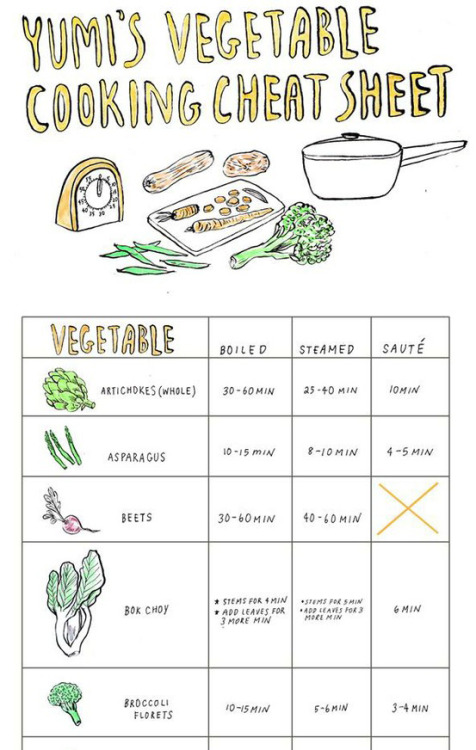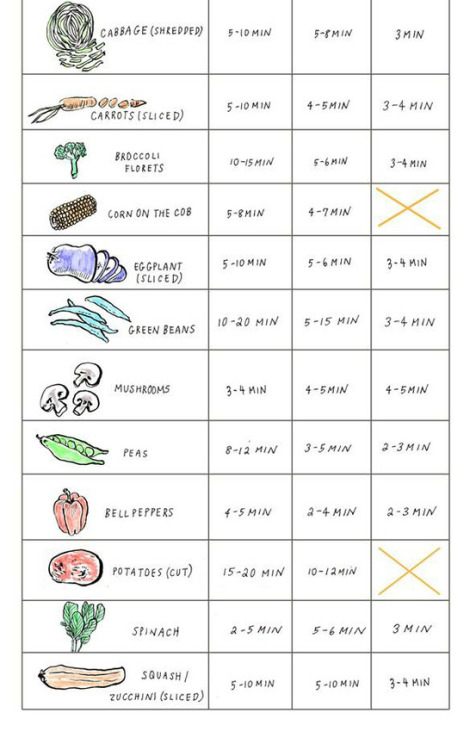Genetics?
date: 2012-10-30  time: 10:49:50
time: 10:49:50
 time: 10:49:50
time: 10:49:50 You want to get healthier and look fit.
You can't figure out why all the hours in the gym aren't paying off.
You 'think' you eat clean most of the time.
It must be your genetics because you are doing everything you are suppose to.
WRONG!!!
Sorry to break it to you but I am going to be straight forward about this. Unless you have a serious medical issue, it's more than likely that your lack of results is because of what you are consuming!!

Honestly, I always heard that 80% of your physical condition had to do with what you ate, but I never really believed it. Well, let me tell you, it's true!
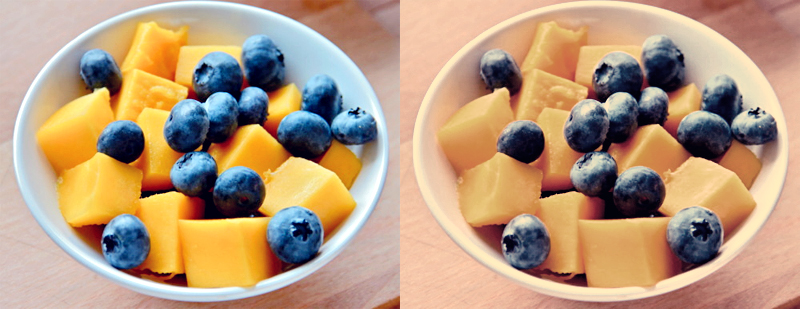
It literally took me months to realize this. I finally decided to stop making excuses as to why I couldn't consistently eat clean and workout. I stepped up to the plate and proved myself wrong and the 80/20 theory is right.
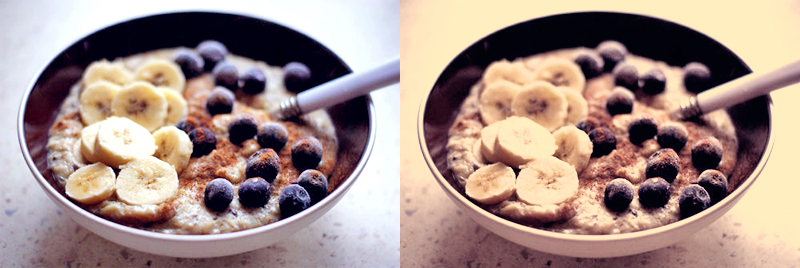
I also learned the hard way that even though you eat clean 6/7 days, it's not enough. Eating clean 6 days out of 7 does not entitle you to eat junk food for a full day. It's called a cheat 'meal' as in one or two a week, not a 'free-for-all'. Take it from me, there's a reason why it took me so long to get where I am today and I am still learning to improve this lifestyle.
How to eat slowly
date: 2012-10-28  time: 19:01:14
time: 19:01:14
 time: 19:01:14
time: 19:01:14 Busy people are experts in efficiency. Everything we do is quick, effective and goal-directed. But when it comes to eating, efficiency is not the highest virtue. Quick eating almost always results in overeating. This is because your brain is not focused on the eating process, but on the goal of filling your stomach. Unfortunately, a full stomach does not automatically create satiety in the brain. Satiety is only percieved after a culmination of sensory cues and signals indicate a meal is over. Some of these cues are internal, such as spending time chewing, tasting and swallowing. Others are external, like seeing an empty plate or noticing a restless dining partner. Only after about 20 minutes will you actually be able to tell if your belly is full or not, but if you've been stuffing your face the entire time it is already too late. You can learn to eat more slowly by focusing on satiety cues rather than on cleaning your plate. Here are 12 tips for learning how to slow down and eat less.

12 Tips For Eating Slowly
1. Practice.
Eating quickly is a habit that needs to be broken. Make a point to practice mindful eating by scheduling it into your day. Write it in your calendar, leave notes on your fridge and send yourself reminders before meals until your new habits become automatic. Habits typically take 3-4 weeks to develope.
2. Sit at a table.
Sitting at a table to eat tells your brain you are having a meal. If you eat while running errands or standing at the counter you can quickly lose track of how much you've eaten. Even if you eat a lot while standing, you may still feel like you haven't had a meal and want to eat more later.
3. Serve small portions.
A clean plate is an incredibly powerful cue that a meal is finished. For this reason, large portion sizes often lead to overeating simply because of our tendency to eat what is in front of us. Serve yourself smaller portions as a reminder to take your time and savor each bite. Use small plates so your brain doesn't perceive the portions as skimpy.
4. Remove distractions.
If you are reading or watching TV, you are not paying attention to the food you put into your mouth. I know you are busy and want to multitask, but resist the urge for 15 minutes and eat a real meal. I admit I'm bad at this one, but I always eat less if I go offline while I eat.
5. Chew.
You might think that you chew your food, but there's a good chance you are swallowing a lot of it whole. Take smaller bites and chew your food thoroughly. Notice the texture of what you are eating and appreciate what it adds to your meal. This is something I need to remind myself of directly before I eat, so I keep this on my to-do list.
6. Drink.
Another way you can force yourself to slow down is to consciously sip your drink throughout your meal. This requires you to put your fork down, chew and swallow before eating more. It also adds liquid to your stomach and can help you feel more full. Water is a perfect choice, but even sipping wine can slow down your meal.
7. Put down your fork.
The classic recommendation to put down your fork (or sandwich) between bites has stuck around for one simple reason: it works. When we are not eating mindfully our hands go into shoveling mode, where your fork is primed with another bite almost instantly after popping the last one in your mouth. Putting your fork down forces you to relax a bit and focus on chewing what you already have.
8. Have a conversation.
You only have one mouth, and if you are using it to talk it's really difficult to shove food into it. Eat with friends, have a great conversation and use this as an opportunity to slow down your meal.
9. Eat with other slow eaters.
We all have an unconscious tendency to imitate people we are near. If you are dining with a ferocious eater, you might find yourself mimicking their bad habit and eating quickly just to keep up. To train yourself to eat slower, try finding slow eaters to influence you instead.
10. Don't eat when you're starving.
Nothing makes me more likely to eat quickly than being famished. But sooner or later circumstance will get the better of you and you'll end up hungrier than you should be. I always carry almonds or other nuts around with me for times like this, and I eat exactly 10 nuts to tide me over for an hour or so. After about 15-20 minutes, my hunger subsides enough for me to regain control of my eating speed.
11. Dim the lights.
Environment can have a big impact on our mental state, and you can set your dinner mood by dimming lights or lighting candles. Dim lights induce an inner calmness and make it easier to slow down. On the flip side, be careful when eating under bright, fluorscent lights as they can spur frantic overeating.
12. Play mellow music.
Slow, mellow music can also help set an appropriate eating pace. + is one of my favorite dinner albums, with Ed Sheeran. However, this trick only works if the music is truly slower than your natural, silent eating pace. If your music is any faster you may experience the opposite effect.
The science of snacking
date: 2012-10-28  time: 00:00:00
time: 00:00:00
 time: 00:00:00
time: 00:00:00 Morning snack:
Nutrient breakdown: Carbs (40%), Protein (30%), Fat (30%)
Snacking goal: Boost your energy level and glycogen stores.
Are you at the gym before the crack of dawn? You don't want to run out empty and risk early fatigue from low blood sugar levels. Research shows that the best way to mitigate that is to eat a small meal rich with carbohydrates that do not spur a spike in blood sugar. Because low-glycemic carbs elicit a boost the body uses body fat for energy.
Translation: You can burn more fat if you eat muesli with low-fat milk before a morning workout instead of a bowl of cornflakes. For those who don't work out before breakfast, reserve this snack for midmorning to keep your blood sugar and energy levels up and to maintain your muscle glycogen stores for activity later in the day.
Try:
1 slice whole-grain bread with 1 tbsp natural peanut butter + 2 dl (1 cup) protein-fortified skim milk
1 dl (½ cup) whole-grain cereal + 2 dl (1 cup) low-fat milk + 1 dl (½ cup) blueberries
1 packet plain oatmeal made with 2 dl (1 cup) low-fat milk + 1 dl (½ cup) chopped walnuts

Afternoon snack:
Nutrient breakdown: Carbs (40%), Protein (30%), Fat (30%)
Snacking goal: Calm your cravings, restore glycogen levels.
Hitting the 3.00 PM energy slump can be avoided by snacking two hours after lunch. Doing so has many benefits: It will keep your blood sugar stable, which is key to preventing a dash to the vending machine later - and it will also facilitate muscle recovery and keep glycogen levels up. "A snack that contains fiber, some protein and healthy fat slows digestion and provides more of a time-release supply of energy, rather than a big gush at one time (like from sweets or starchy snacks)", Chernus says.
Try:
1 medium whole-grain tortilla + 2 tbsp hummus + 2 tomato slices + 4 cucumber slices + 30 g (1oz) tuna
1 small pita + 85 g (3oz) chicken breast + 1 dl (½ cup) cucumber slices + 1 slice tomato
1 dl (½ cup) whole-grain couscous + 115 g (4oz) cubed tofu + 1 dl (½ cup) broccoli + 1 tsp olive oil + 1 tbsp balsamic vinegar

Preworkout snack:
Nutrient breakdown: Carbs (60%), Protein (20%), Fat (20%)
Snacking goal: Energize your workouts.
Rev up your workout energy in two ways: Eat a carb-rich snack within and hour or two before you exercise and you'll be able to exercise harder and consequently burn more calories. "Preworkout snacks should be light, easily digested and lower in fat - so there is no decrease in blood flow to the muscles", Gerbstadt says. Secondly, drink water before you go. The American Council on Exercise (ACE) suggests drinking 5-6 dl (16-20oz) of water to prevent dehydration and improve performance.
Try:
3 rye crisp crackers with 1 dl (½ cup) low-fat cottage cheese + 1 small piece of fruit
½ whole-grain English muffin + 2 tbsp hummus + 1 dl (½ cup) fresh berries
2 dl (1 cup) vegetable soup + 3 small whole-grain crackers + 1 dl (½ cup) applesauce

Postworkout snack:
Nutrient breakdown: Carbs (60%), Protein (30%), Fat (10%)
Snacking goal: Repair and jumpstart muscle recovery.
Known in bodybuilding circles as the "window of opportunity", this is a prime time to snack. That's because within 15 minutes of completing your workout, your muscles are like sponges waiting to refill their glycogen stores. So for effective rebuilding and recovery of muscles, eat a carb- and protein-rich snack that's very low in fat. After a 30-minute workout, Gerbstadt recommends "combining a mixture of different types of high-carb foods like fruits, whole-grain breads and pastas with high-protein foods like lean meat, low-fat cheese, yoghurt and whey protein".
Try:
1 dl (½ cup) non-fat chocolate milk + 1 slice whole-grain bread + 1 tbsp natural peanut butter
15 g (½oz) parkt-skim mozzarella + 30 g (1oz) turkey breast + one 15 centimeter (6 inches) corn tortilla + 2 tbsp salsa
40 g (1½oz) roasted unsalted soy nuts + 1 medium fresh orange
Red recovery shake: 2 dl (1 cup) skim milk + 1 dl (½ cup) strawberries + 2 scoops whey protein powder

Bedtime snack:
Nutrient breakdown: Carbs (30%), Protein (50%), Fat (20%)
Snacking goal: Tame cravings and prevent muscle breakdown.
Cap off your day with this optional mini-meal if you are genuinely hungry after an active day. At night, eat a snack that is made up mostly of high-quality protein. "Protein-rich foods supply ready amino acids for repair of muscle during sleep - and rest is when muscle repair occurs", Gerbstadt says. Foods with casein, a primary protein in dairy products, are a good choice as they provide a slow release of amino acids into the bloodstream, which builds muscle and can prevent muscle breakdown overnight.
Try:
1 dl (½ cup) low-fat cottage cheese + apple slices
Fruity Milk Shake: 2 dl (1 cup) low-fat milk + 1 scoop whey protein powder + 2 strawberries + ½ dl (1/4 cup) blueberries
1 low-fat string cheese + 1 small pear

Turn a banana into a power snack:
Portable and potassium-packed, there's no denying that a banana is a healthy food. But a single banana may not provide the ideal mix of macronutrients to support your body-shaping goals. Upgrade it to a super snack anytime of the day by adding the following foods to it:
Morning: 1 medium banana + 1 tbsp natural almond butter + 2 dl (1 cup) water
Afternoon: 1 medium banana + 1 3/4 dl (3/4 cup) low-fat cottage cheese + 2 dl (1 cup) water
Preworkout: 1 medium banana + 2 dl (1 cup) skim milk + ½ dl (1/4 cup) strawberries + 1 scoop whey protein
Postworkout: 1 small banana + 1 slice whole-grain bread + 1 slice low-fat cheese + 2 dl (1 cup) water
Bedtime: 1 small banana + ½ dl (1/4 cup) nuts (almonds, walnuts or pistachios) + 2 dl (1 cup) water
Why are you hungry all the time?
date: 2012-10-26  time: 19:54:22
time: 19:54:22
 time: 19:54:22
time: 19:54:22 So you're trying to change your lifestyle for the better? But you can't help but feel hungry all the time! There might be a reason for that.
THE AMOUNT
You've changed your daily meals with vegetables, fruits and other low-calorie foods, but you're eating the same amount of food as before. Vegetables are not as filling as your usual meat and bread foods, so you'll need to eat more of the good food to feel and be satisfied.

COMFORT EATING
How was your day? Not too good? It doesn't take long until you feel the old familiar feeling of hunger? Well, think again before you take a bite of that chocolate or anything else you might just be comfort eating. Find something else to do when you're feeling down or bored.

BRAIN CONFUSION
Your brain sometimes confuses thirst with hunger. Before you take something to eat try having a glass of water instead!

LACK OF NUTRITION
Sometimes when you're trying to addapt to a new lifestyle you don't always know how to eat properly. Your body might be craving some important nutritions you're lacking of.
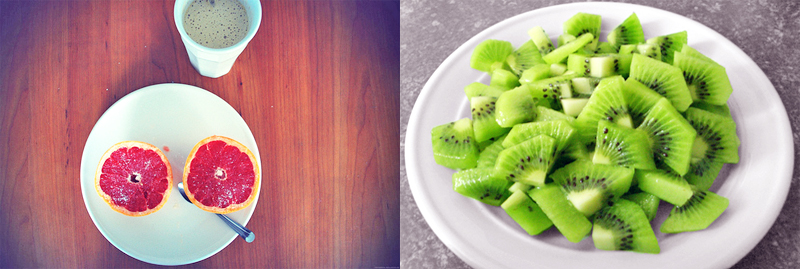
EAT BREAKFAST
Do you think you're saving calories by skipping breakfast? Think again. By skipping breakfast you're more likely to feel hungry throughout the day and also overeat. Always eat something within an hour of awakening to keep your body optimized!
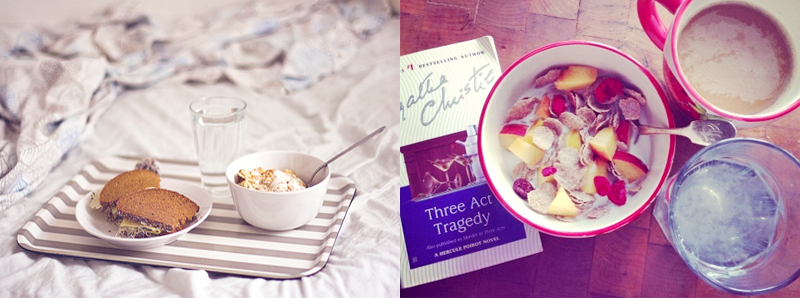
My tips for eating out at a restaurant when trying to stick to your diet
date: 2012-10-18  time: 18:45:00
time: 18:45:00
 time: 18:45:00
time: 18:45:00 If this is cheat meal, then obviously some of these things may not need apply.
 Don't go starving. You are less likely to choose the greasiest, most unhealthy thing on the menu if you don't go to the restaurant ravenous. Have a small snack consisting of protein about an hour or so before you leave.
Don't go starving. You are less likely to choose the greasiest, most unhealthy thing on the menu if you don't go to the restaurant ravenous. Have a small snack consisting of protein about an hour or so before you leave. Avoid the bread basket or chips and salsa. It's easy to mindlessly fill up on the empty carbs before your meal even arrives. The chips and bread can add hundreds of calories to what could have been a low-calorie night out.
Avoid the bread basket or chips and salsa. It's easy to mindlessly fill up on the empty carbs before your meal even arrives. The chips and bread can add hundreds of calories to what could have been a low-calorie night out. Skip the appetizer. As with the bread basket, it can add hundreds more calories and probably a lot more UNhealthy fats and simple carbs to what could be a healthy night out. If you do pick an appetizer, choose something that isn't fried or packed with things like full fat cheeses.
Skip the appetizer. As with the bread basket, it can add hundreds more calories and probably a lot more UNhealthy fats and simple carbs to what could be a healthy night out. If you do pick an appetizer, choose something that isn't fried or packed with things like full fat cheeses. If you order a salad before your meal, be aware that while most side salads ARE low in calories (if they aren't littered with nuts, dried fruit, cheese or croutons)...most dressings are LOADED with sugar and fat. Avoid creamy dressings like ranch, blue cheese and thousand island. Choose vinaigrettes instead. While vinaigrettes can still be high in calories, fat and sugar, they are the "safer" choice.
If you order a salad before your meal, be aware that while most side salads ARE low in calories (if they aren't littered with nuts, dried fruit, cheese or croutons)...most dressings are LOADED with sugar and fat. Avoid creamy dressings like ranch, blue cheese and thousand island. Choose vinaigrettes instead. While vinaigrettes can still be high in calories, fat and sugar, they are the "safer" choice. The above-mentioned guideline about side salads applies to regular salads as well. A lot of people assume if they order a salad, they are choosing something healthy and relatively low in calories. Think again! Most salads can pack more calories, sugar and fats than a burger and fries combined! Things like dried fruit, nuts, full-fat cheeses, croutons and other toppings will make what was originally a low calorie, low fat, low sugar bowl of lettuce/spinach and turn it into a mound of calorie overload. This doesn't mean you shouldn't order a salad, it just means you should be aware that you are not necessarily choosing something that will work with your daily macros/calorie intake.
The above-mentioned guideline about side salads applies to regular salads as well. A lot of people assume if they order a salad, they are choosing something healthy and relatively low in calories. Think again! Most salads can pack more calories, sugar and fats than a burger and fries combined! Things like dried fruit, nuts, full-fat cheeses, croutons and other toppings will make what was originally a low calorie, low fat, low sugar bowl of lettuce/spinach and turn it into a mound of calorie overload. This doesn't mean you shouldn't order a salad, it just means you should be aware that you are not necessarily choosing something that will work with your daily macros/calorie intake. Avoid ordering foods that have any of these words below them: breaded, battered, crispy, crunchy, crusted, buttered, cheesy, country-style, creamy, glazed, gooey, honey-dipped, melted, smothered or fried. These are all extremely good indicators of un-healthy-, fat-, carb- and sugar-loaded junk!
Avoid ordering foods that have any of these words below them: breaded, battered, crispy, crunchy, crusted, buttered, cheesy, country-style, creamy, glazed, gooey, honey-dipped, melted, smothered or fried. These are all extremely good indicators of un-healthy-, fat-, carb- and sugar-loaded junk! Look instead for options that contain the following: baked, broiled, roasted, fresh, multi-grain, broth, seared, poached, grilled, sautéed, spiced, and steamed.
Look instead for options that contain the following: baked, broiled, roasted, fresh, multi-grain, broth, seared, poached, grilled, sautéed, spiced, and steamed. Don't be afraid to ask the server for the nutrition facts menu. This way you can see an even more specific choice! You can also scope out substitutes for some of the ingredients and/or sides that your meal comes with!
Don't be afraid to ask the server for the nutrition facts menu. This way you can see an even more specific choice! You can also scope out substitutes for some of the ingredients and/or sides that your meal comes with! Also, don't be afraid to ask for things on the side! Dressings, marinades, high-calorie toppings and adders, syrups and other extras can be more easily controlled if you can put them on yourself! Don't add salt! I can almost GUARANTEE whatever you wind up ordering will likely come loaded with salt.
Also, don't be afraid to ask for things on the side! Dressings, marinades, high-calorie toppings and adders, syrups and other extras can be more easily controlled if you can put them on yourself! Don't add salt! I can almost GUARANTEE whatever you wind up ordering will likely come loaded with salt. Restaurants are notorious for WAY overdoing the portion sizes. Save half or more of your meal for later! That way you can get two or more meals out of it! You can ask the server to pack half of it up before it even gets to your table (or if you have the will-power, eat half and ask for a to go box after).
Restaurants are notorious for WAY overdoing the portion sizes. Save half or more of your meal for later! That way you can get two or more meals out of it! You can ask the server to pack half of it up before it even gets to your table (or if you have the will-power, eat half and ask for a to go box after). Also, consider ordering something to split with a friend, family member or significant other! That way you don't have to worry about carrying the leftovers home and you can both enjoy a lighter dinner!
Also, consider ordering something to split with a friend, family member or significant other! That way you don't have to worry about carrying the leftovers home and you can both enjoy a lighter dinner! Lastly, skip dessert. You'll be glad you did. Some single slices of cheesecake and other goodies can pack more than 1000 calories!!!
Lastly, skip dessert. You'll be glad you did. Some single slices of cheesecake and other goodies can pack more than 1000 calories!!!
While you might be thinking "I don't want to be annoying by asking for all kinds of ingredients on the side"...don't. If the restaurant had been smart enough to provide healthier options, they wouldn't have had to worry about people ordering substitutes and giving special instructions. In addition, remember that many people with severe food allergies also must ask the server to have the food prepared sans their allergen! Don't be shy about speaking up! If it's a first date or something, I might understand the hesitation...but even still...don't be afraid to ask nicely for what you want!
10 food additives to avoid
date: 2012-10-15  time: 21:32:03
time: 21:32:03
 time: 21:32:03
time: 21:32:03 Food additives have been used for centuries to enhance the appearance and flavor of food and prolong shelf life. But do these food additives really “add” any value to your food? Food additives find their way into our foods to help ease processing, packaging and storage. But how do we know what food additives is in that box of macaroni and cheese and why does it have such a long shelf life? A typical American household spends about 90 percent of their food budget on processed foods, and are in doing so exposed to a plethora of artificial food additives, many of which can cause dire consequences to your health.
Some food additives are worse than others. Here’s a list of the top food additives to avoid:

Aspartame (E951), more popularly known as Nutrasweet and Equal, is found in foods labeled "diet" or "sugar free" and is aprox. 200 times sweeter than actual sugar. Aspartame is believed to be carcinogenic and accounts for more reports of side effects than all other foods and food additives combined. Aspartame is not your friend. Aspartame is a neurotoxin, known to erode intelligence and affect short-term memory. The components of this toxic sweetener may lead to a wide variety of aliments including brain tumor, diseases like lymphoma, diabetes, multiple sclerosis, Parkinson's, Alzheimer's, fibromyalgia, and chronic exhaustion, emotional disorders like depression and anxiety attacks, dizziness, headaches, nausea, mental confusion, migraines, and seizures. Acesulfame-K, a relatively new artificial sweetener found in baking goods, gum and gelatin, has not been thoroughly tested and has been linked to kidney tumors. Read more about the dangers of Aspartame here.
Found in/are allowed in: Diet or sugar free sodas, diet coke, coke zero, jello (and over gelatins), desserts, sugar free gum, drink mixes, baking goods, table top sweeteners, cereal, breathmints, pudding, kool-aid, ice tea, chewable vitamins, toothpaste, fruityoghurt, ice cream, confectionary, jam, marmelade, mustard, condiments.


High fructose corn syrup (HFCS) is a highly-refined artificial sweetener which has become the number one source of calories in America. It's found in almost all processed foods. HFCS packs on the pounds faster than any other ingredient, increases your low-density lipoprotein (LDL) ["bad"] cholesterol levels, and contributes to the development of diabetes and tissue damage, among other harmful effects.
Found in/are allowed in: Most processed foods, breads, candy, flavored yoghurts, salad dressings, canned vegetables, cereals.


MSG is an amino acid used as a flavor enhancer in soups, salad dressings, chips, frozen entrees, and many restaurant foods. MSG is known as an excitotoxin, a substance which overexcites cells to the point of damage or death. Studies show that regular consumption of MSG may result in negative side effects which include depression, disorientation, eye damage, exhaustion, headaches, and obesity. MSG effects the neurological pathways of the brain and declutch the "I'm full" function which explains the effects of weight gain.
Found in/are allowed in: Chinese food (restaurant), many snacks, chips, cookies, seasonings, most Campbell Soup products, frozen dinners, lunch meats.
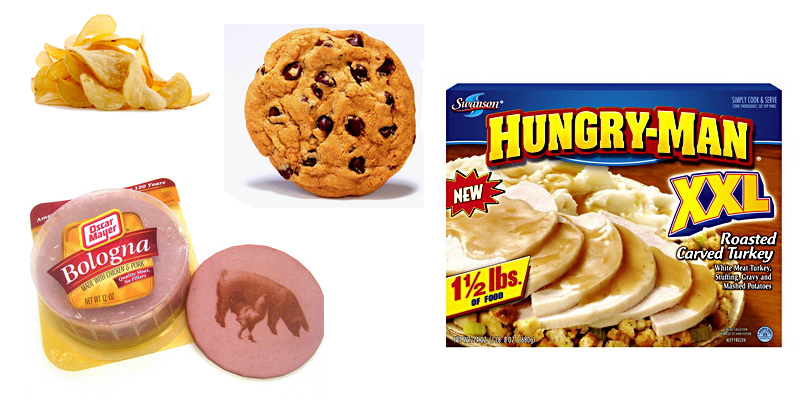

Trans fat is used to enhance and extend the shelf life of food products and is among the most dangerous substances that you can consume. Found in deep-fried fast foods and certain processed foods made with margarine or partially hydrogenated vegetable oils. Trans fats are formed by a process called hydrogenation. Numerous studies show that trans fat increases low-density lipoprotein (LDL) cholesterol levels while decreasing high-density lipoprotein (HDL) ["good"] cholesterol, increases the risk of heart attacks, heart disease and strokes, and contributes to increased inflammation, diabetes and other health problems. Oils and fat are now forbidden on the Danish market if they contain trans fatty acids exceeding 2%, a move that effectively bans partially hydrogenated oils.
Found in/are allowed in: Margarine, chips and crackers, baked goods, fast foods.


Studies show that artificial colorings which are found in soda, fruit juices and salad dressings may contribute to behavioral problems in children and lead to a significant reduction in IQ. Animal studies have linked other food colorings to cancer. Watch out for these ones:

Banned in Norway, Finland and France. May cause chromosomal damage and allergy-like symptoms on people who are especially sensitive. Syndromes may be hay-fever, hives and asthma.
Found in/are allowed in: Candy, cereal, soft drinks, sports drinks and pet foods.

Banned in 1990 after 8 years of debate from use in many foods and cosmetics. This dye continues to be on the market until supplies run out! Has been proven to cause thyroid cancer and chromosomal damage in laboratory animals, may also interfere with brain-nerve transmission.
Found in/are allowed in: Fruit cocktail, maraschino cherries, cherry pie mix, ice cream, candy, bakery products, certain tradiotional sausauges and marmelades.

Banned in Norway and Sweden. Increases the number of kidney and adrenal gland tumors in laboratory animals, may cause chromosomal damage.
Found in/are allowed in: American cheese, macaroni and cheese, candy and carbonated beverages, lemonade and more!
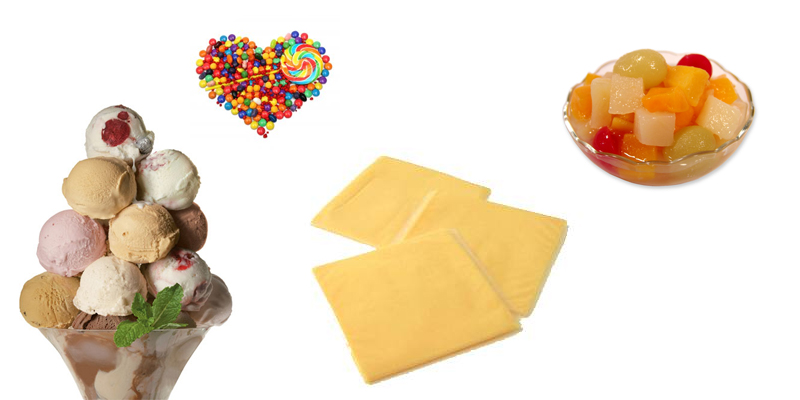

Preservative used in wine-making and other processed foods. According to the food and drug administration (FDA), approximately one in 100 people is sensitive to sulfites in food. The majority of these individuals are asthmatic, suggesting a link between asthma and sulfites. Individuals who are sulfite sensitive may experience headaches, breathing problems and rashes. In severe cases, sulfites can actually cause death by closing down the airway altogether, leading to cardiac arrest.
Found in/are allowed in: Wine and dried fruit.


Sodium nitrate (or sodium nitrite) is used as a preservative, coloring and flavoring in bacon, ham, hot dogs, luncheon meats, corned beef, smoked fish and other processed meats. This ingredient, which sounds harmless, is actually highly carcinogenic once it enters the human digestive system. There, it forms a variety of nitrosamine compounds that enter the bloodstream and wreak havoc with a number of internal organs: the liver and pancreas in particular. Sodium nitrite is widely regarded as a toxic ingredient, and the US Department of Agriculture (USDA) actually tried to ban this additive in the 1970's but was vetoed by food manufacturers who complained they had no alternative for preserving packaged meat products. Why does the industry still use it? Simple: this chemical just happens to turn meats bright red. It's actually a color fixer, and it maked old, dead meats appear fresh and vibrant.
Found in/are allowed in: Hot dogs, bacon, ham, luncheon meat, cured meats, corned beef, smoked fish or any other type of processed meat.
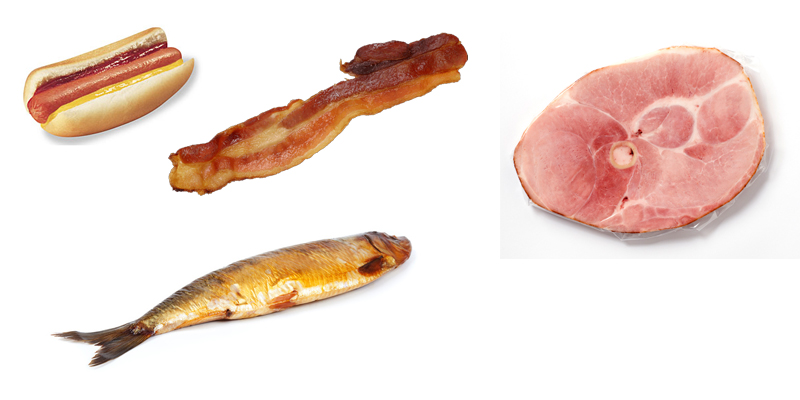

Butylated hydroxyanisole (BHA) and butylated hydrozyttoluene (BHT) are preservatives found in cereals, chewing gum, potato chips and vegetable oils. This common preservative keeps food from changing color, changing flavor or becoming rancid. Effects the neurological system of the brain, alters behavior and has potential to cause cancer. BHA and BHT are oxidants which form cancer-causing reactive compounds in your body.
Found in/are allowed in: Potato chips, gum, cereal, frozen sausages, enriched rice, lard, shortening, candy, jello.
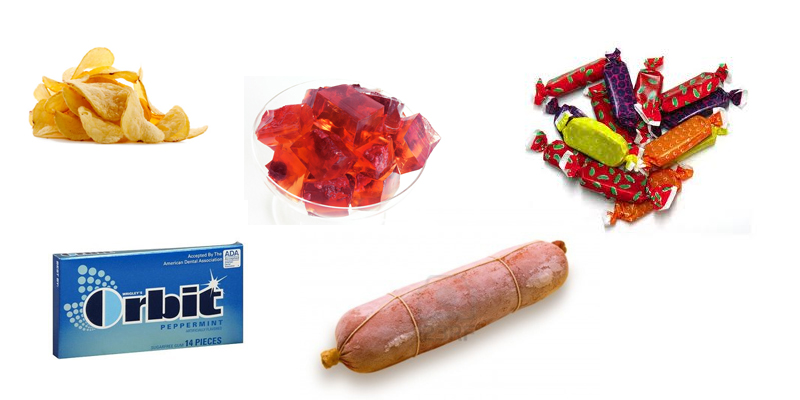

Sulfur additives are toxic and in the United States of America, the Federal Drugs Administration have prohibited their use on raw fruit and vegetables. Adverse reactions include: bronchial problems particularly in those prone to asthma, hypotension (low blood pressure), flushing tingling sensations or anaphylactic shock. It also destroys vitamins B1 and E. Not recommended for consumption by children. The International Labour Organisation says to avoid E220 if you suffer from conjuctivitis, bronchitis, emphysema, bronchial asthma or cardiovascular disease.
Found in/are allowed in: Beer, soft drinks, dried fruit, juices, cordials, wine, vinegar and potato products.


An additive used to increase volume in some white flour, breads and rolls. Potassium Bromate is known to cause cancer in animals. Even small amounts in bread can create problems for humans.
Found in/are allowed in: Breads.

23 ways to eat clean
date: 2012-10-14  time: 22:09:36
time: 22:09:36
 time: 22:09:36
time: 22:09:36 1. Apples
 Apple
Apple Applesauce
Applesauce Apple toaster pastry
Apple toaster pastry While applesauce is a healthy choice, it has fewer nutrients than a whole apple.
While applesauce is a healthy choice, it has fewer nutrients than a whole apple.2. Oranges
 Orange
Orange 100% orange juice
100% orange juice Orange drink
Orange drink Many fruit drinks contain high fructose corn syrup and little real juice.
Many fruit drinks contain high fructose corn syrup and little real juice.3. Strawberries
 Fresh strawberries
Fresh strawberries Strawberry preserves
Strawberry preserves Strawberry gelatin dessert
Strawberry gelatin dessert Gelatin desserts usually contain artificial strawberry flavor, not real fruit.
Gelatin desserts usually contain artificial strawberry flavor, not real fruit.4. Peaches
 Peach
Peach Canned peaches in 100% juice
Canned peaches in 100% juice Canned peaches in heavy syrup
Canned peaches in heavy syrup Fruit canned in heavy syrup has more sugar and calories than fresh fruit.
Fruit canned in heavy syrup has more sugar and calories than fresh fruit.5. Figs
 Fresh figs
Fresh figs Fig preserves
Fig preserves Fig sandwich cookies
Fig sandwich cookies Packaged fruit cookies may contain refined sugar and preservatives.
Packaged fruit cookies may contain refined sugar and preservatives.6. Pineapple
 Pineapple
Pineapple Canned diced pineapple
Canned diced pineapple Pineapple cocktail soup
Pineapple cocktail soup Fresh pineapple is higher in vitamins C and A and beta-carotene than canned.
Fresh pineapple is higher in vitamins C and A and beta-carotene than canned.7. Corn
 Corn on the cob
Corn on the cob Corn tortilla chips
Corn tortilla chips Cornflakes
Cornflakes Buy tortilla chips with just three ingredients: whole corn, oil and salt - and eat in moderation.
Buy tortilla chips with just three ingredients: whole corn, oil and salt - and eat in moderation.8. Spinach
 Spinach
Spinach Bagged prewashed spinach
Bagged prewashed spinach Frozen creamed spinach
Frozen creamed spinach When buying frozen vegetables, avoid those packaged with sodium-rich sauces. Buy plain and add your own light sauce.
When buying frozen vegetables, avoid those packaged with sodium-rich sauces. Buy plain and add your own light sauce.9. Garlic
 Garlic
Garlic Jarred minced garlic
Jarred minced garlic Bottled garlic marinade
Bottled garlic marinade Minced fresh garlic is cheaper and more flavorful than jarred.
Minced fresh garlic is cheaper and more flavorful than jarred.10. Carrots
 Carrots
Carrots Baby carrots
Baby carrots Frozen honey-glazed carrots
Frozen honey-glazed carrots Baby carrots are healthy but more expensive than regular-size loose carrots.
Baby carrots are healthy but more expensive than regular-size loose carrots.11. Soup
 Soup from scratch
Soup from scratch Canned soup
Canned soup Dehydrated soup mix
Dehydrated soup mix Homemade soup often has less sodium and more flavor than canned.
Homemade soup often has less sodium and more flavor than canned.12. Ham
 Heritage ham
Heritage ham Deli ham
Deli ham Packaged deli bologna
Packaged deli bologna Heritage varieties of pork are much less likely to contain hormones than factory meat is.
Heritage varieties of pork are much less likely to contain hormones than factory meat is.13. Turkey
 Whole turkey
Whole turkey Deli turkey
Deli turkey Store-bought turkey meatballs
Store-bought turkey meatballs If you buy turkey and other meats at the deli counter, ask for brands free of fillers and nitrates.
If you buy turkey and other meats at the deli counter, ask for brands free of fillers and nitrates.14. Beef
 Grass-fed beef
Grass-fed beef Grain-fed beef
Grain-fed beef Frozen beef patties
Frozen beef patties Grass-fed beef meat is higher in nutrients and lower in fat than grain-fed beef.
Grass-fed beef meat is higher in nutrients and lower in fat than grain-fed beef.15. Chicken
 Fresh chicken breasts
Fresh chicken breasts Deli sliced chicken
Deli sliced chicken Chicken nuggets
Chicken nuggets Chicken nuggets contain very little real chicken.
Chicken nuggets contain very little real chicken.16. Eggs
 Pasture-raised eggs
Pasture-raised eggs Omega-3-fortified eggs
Omega-3-fortified eggs Egg beaters
Egg beaters Pasture-raised eggs may have 35% less saturated fat, 60% more vitamin A, and 200% more omega-3s compared to omega-3-fortified eggs and egg beaters, which come from chickens kept in coops.
Pasture-raised eggs may have 35% less saturated fat, 60% more vitamin A, and 200% more omega-3s compared to omega-3-fortified eggs and egg beaters, which come from chickens kept in coops.17. Cream
 Cream
Cream Fat-free half cream / half milk
Fat-free half cream / half milk Flavored dairy creamer
Flavored dairy creamer Flavored dairy creamers are often made with colorings, artificial flavors, and corn syrup.
Flavored dairy creamers are often made with colorings, artificial flavors, and corn syrup.18. Yoghurt
 Plain yoghurt
Plain yoghurt Flavored yoghurt
Flavored yoghurt Flavored yoghurt drink
Flavored yoghurt drink Buy plain yoghurt and flavor it at home with honey or fresh fruit.
Buy plain yoghurt and flavor it at home with honey or fresh fruit.19. Bread
 Whole grain bread
Whole grain bread Wheat bread
Wheat bread Fortified white bread
Fortified white bread If a whole grain isn't the first ingredient, you're missing out on nutrients.
If a whole grain isn't the first ingredient, you're missing out on nutrients.20. Pasta
 Dried whole wheat pasta
Dried whole wheat pasta Dried white pasta
Dried white pasta Instant noodles
Instant noodles Whole wheat pasta is higher in antioxidants than white or instant noodles.
Whole wheat pasta is higher in antioxidants than white or instant noodles.21. Rice
 Brown rice
Brown rice White rice
White rice Flavored instant rice
Flavored instant rice Brown rice, unlike white, hasn't had its fiber-rich layers of bran and germ removed.
Brown rice, unlike white, hasn't had its fiber-rich layers of bran and germ removed.22. Peanuts
 Peanuts
Peanuts Natural peanut butter
Natural peanut butter Processed peanut butter
Processed peanut butter Natural peanut butter should contain only peanuts and a dash of salt.
Natural peanut butter should contain only peanuts and a dash of salt.23. Soy
 Fresh edamame (whole soybeans)
Fresh edamame (whole soybeans) Tofu
Tofu Frozen veggie burgers (containing soy ingredients)
Frozen veggie burgers (containing soy ingredients) Frozen veggie burgers are vegetarian-friendly but are highly processed.
Frozen veggie burgers are vegetarian-friendly but are highly processed.Before/after workout snacks
date: 2012-09-30  time: 01:02:00
time: 01:02:00
 time: 01:02:00
time: 01:02:00 BEFORE
Before your workout, have something small, but high-carb, for energy.
- a banana
- an apple
- oatmeal
- healthy cereal
- whole wheat english muffin with jam

AFTER
After your workout, have something with protein to rebuild your tired muscles.
- apple with peanut butter or low-fat cheese
- banana with peanut butter
- carrot- and celery sticks with 1-2 tbsp of dressing
- berries with ricotta cheese
- high-protein, high-fiber cereal
- yoghurt with granola or fruit
- protein and fruit smoothie
- peanut butter and banana on rice cakes
- chicken/tuna/turkey on a slice or two of whole wheat bread
- a handful of nuts and raisins
- cereal bar
- cottage cheese
Make a salad under 200 calories
date: 2012-09-30  time: 00:36:00
time: 00:36:00
 time: 00:36:00
time: 00:36:00 A salad can be a great low-calorie snack for those times when you just want to eat something!
LETTUCE:
The most basic part of a salad is the lettuce. Choose one, or choose three. It doesn't matter!
- iceberg
- romaine (recommended)
- arugula
- mesclun
- oakleaf
- watercress

DRESSING:
Keep it light! You'd be surprised how adding the right combos of ingredients to your salad can actually make it taste much better than when it's drowned in dressing. Try not to use more than 1-2 servings of any dressing, and go light!
- lemon
- lime
- light italian
- raspberry vinaigrette
- all natural olive oil
- other oils can be yummy too
ADDING THE GOOD STUFF:
Add what you like to your salad, items with a "*" are very low in calories.
- tomato *
- walnuts
- strawberries
- yoghurt
- chicken
- kiwi
- spinach *
- black beans *
- corn *
- bell pepper
- sprinkle of cheese
- cucumber

13 tricks and tips for keeping produce fresh longer
date: 2012-09-27  time: 22:57:00
time: 22:57:00
 time: 22:57:00
time: 22:57:00 Ever wonder why your fruit bowl looks like a sixth-grade science project only days after you set it out? As some fruits and vegetables ripen, they release a gas that can cause other produce to become spotted, soft, or mealy.
1. Some fruits and veggies produce a gas called ethylene as they ripen. This gas can prematurely ripen foods that are sensitive to it, so keep ethylene-producing foods away from ethylene-sensitive foods. Avocados, bananas, cantaloupes, kiwis, mangoes, nectarines, pears, plums and tomatoes, for example, should be stored in a different place than your apples, broccoli, carrots, leafy greens and watermelon. Get a longer list of fruits to store separately here.
2. Keep potatoes, onions and tomatoes in a cool, dry place, but not in the fridge. The cold will ruin their flavour.
3. Store unripe fruits and veggies like pears, peaches, plums, kiwis, mangoes, apricots, avocados, melons and bananas on the counter. Once they're ripe, move them to the fridge. Banana peels will turn dark brown, but it won't affect the flesh.
4. Store salad greens and fresh herbs in bags filled with a little air and sealed tightly.
5. Citrus fruits such as oranges, tangerines, lemons and limes will do fine for up to a week in a cool, dark place, away from direct sunlight, but you can lenghten their lives by storing them in the fridge in a mesh or perforated plastic bag.
6. Wrap celery in aluminum foil and store it in the veggie bin in the fridge.

7. Other types of produce such as carrots, lettuce and broccoli start to spoil as soon as they're picked, so place these in separate plastic baggies in the crisper in your fridge as soon as possible [make sure they're dry though, since moisture speeds up spoiling].
8. Cut the leafy tops of your pineapple off and store your pineapple upside down. This helps redistribute sugars that sink to the bottom during shipping and also helps it keep longer.
9. Avoid washing berries until right before you're ready to eat them. Wetness encourages mold growth.
10. If you like to wash, dry and cut your fruits and veggies all at once, store them in covered glass containers lined in paper towels. You'll not only be able to see them - which reminds you to eat them - but you'll also be keeping moisture out.
11. If you normally forget to use up fruits and veggies if you put them in the crisper, store your veggies in plain sight in Evert-Fresh or reusable produce bags that mimic your crisper's function.
12. Buy only what you need. Go to the market more frequently, or if that's not possible, plan out your meals ahead of time so you only buy what you know you'll use.
13. If you notice any rotten produce, compost it immediatly before it starts to spoil the rest of the produce.
.
Burn fat fast - the new vitamin D diet
date: 2012-09-18  time: 18:04:00
time: 18:04:00
 time: 18:04:00
time: 18:04:00 The sunshine vitamin affects us more than we previously thought. Vitamin D makes you both more energetic, happier - and slimmer, a new research shows.
In 2008, researchers at University of Minnesota made 38 people who were all overweight eat according to a precarious nutrition program for eleven weeks. Every day the participants ate 750 calories less than the recommended daily intake, and of course everyone lost weight. But those who had high levels of vitamin D in their blood at the beginning of this research had a much more efficient weight loss. They lost up to 70% more fat than the other participants.
With this background, "the vitamin D diet" developed. A method that briefly contains of you eating vitamin D combined with five other fatburning catalysts (read about them under the picture ↓). By including these key ingredients in your diet the body's fat burning process will constantly be at full speed, according to the authors of the book The Vitamin D Diet.
Being outdoors in the sun is the easiest way to fill up with vitamin D. You can also eat fatty fish (like salmon), eggs and enriched dairy products like milk to increase your vitamin D intake.

THE OTHER FIVE FATBURNING CATALYSTS:
CALCIUM
This important mineral is a real sidekick to vitamin D, because together they turn up your metabolism a level. Calcium is in fact naturally in the fat cells, and studies show that the more calcium a cell has, the more fat it can let go of. Furthermore, calcium can bind fat and thus prevent the body from absorbing it at all.
Can be found in: Dairy products
PROTEIN
If you consume foods high in protein you can be sure that your muscle mass will be kept intact at weight loss. Protein satiates and helps the body to balance the amount of fat versus muscles effectively. Muscles require more energy than fat, so in the long term a percentage conversion of fat to muscle have a strong effect on your metabolism. Women who eat protein twice a day loose on average 4% more fat than women who doesn't, according a study at University of Illinois.
Can be found in: Meat, fish, tofu
OMEGA-3
This fatty acid facilitates weight loss by triggering fat burning enzymes. Omega-3 also has an effect on your mood, something that researches believe prevents us from bingeing. Studies have also shown that omega-3 can increase the body's production of leptin, a substance that regulates appetite and turn up the fat burning process. Most foods that are high in vitamin D also contains omega-3.
Can be found in: Salmon, nuts and seeds
MONOUNSATURATED FATS
This type of fat has an ability to stabilize blood sugar levels and reduce appetite. Monounsaturated fats also tend to counteract the harmful abdominal fat. A Danish study also shows that this type of fat can turn up the fat burning process.
Can be found in: Olive oil, nuts, seeds, avocado and chocolate
CLA - Conjugated Linoleic Acid
CLA is found naturally in meat and dairy products. This fatty acid prevents the body to absorb fat from food while benefiting from the release of hormones that promote fat burning.
Can be found in: Meat from cattle and dairy products.
Cooking sheet
Eat healthy, feel happy - psychological effects of eating healthy!
date: 2012-09-13  time: 20:15:14
time: 20:15:14
 time: 20:15:14
time: 20:15:14 What you put into your body not only affects your physical well-being, but it can also impact your overall psychological well-being. Foods influence mood and contribute to the experience of both positive and negative feelings. Therefore, making healthy food choices can contribute to a variety of improvements to your overall mental and psychological well-being.
REDUCING MENTAL ILLNESS
Eating a healthy, well-balanced diet has been shown to impact a number of mental health conditions positively. Healthy eating can help reduce depression symptoms, reduce the chances of bipolar episodes, reduce anxiety and reduce the negative symptoms of attention-deficit/hyperactivity disorder. Eating regular, healthy meals can keep blood sugar levels steady which can reduce the dips in mood associated with depression and anxiety. Also, a diet that is based in healthy eating will limit the sugar intake, which will keep sugar-induced spikes in energy from triggering episodes of mania. The symptoms of attention-deficit/hyperactivity disorder can be reduced by healthy eating, because low sugar diets and diets comprised of healthy vegetables and fruits can help improve concentration and reduce hyperactivity. In addition, a healthy diet will keep alcohol intake to a minimum, which will help reduce all these mental health symptoms. Depression, anxiety, bipolar disorder and attention-deficit/hyperactivity disorder can all be triggered or worsened by alcohol intake.

INCREASED ENERGY
A healthy diet can boost your energy levels. Energy can improve your mood and make you feel better about yourself. Unhealthy foods, such as those high in sugar and refined grains, provide an increase in energy levels that dip shortly after they spike. After eating these foods, you will experience short bursts of energy, but they will not be sustained, and then you will feel fatigued. Eating healthy foods will keep your energy levels up. Some energy-sustaining healthy foods include fruits, vegetables, whole grain pastas, brown rice, whole grain bread, lean animal-based proteins and plant-based proteins, such as beans and nuts.
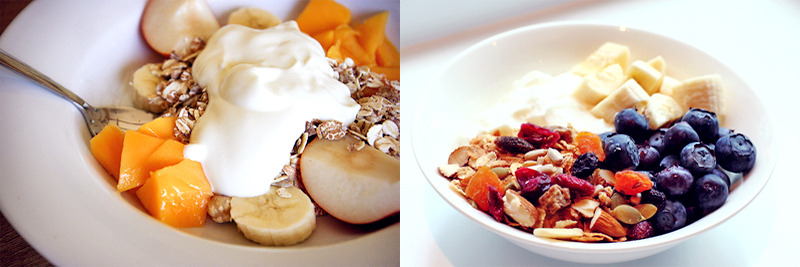
KEEP BRAIN SHARP
The nutrition in healthy foods can help maintain healthy brain activity. The Diet Channel website reports healthy eating can keep your brain functioning to its highest potential. According to the CNN website, eating certain foods can help boost your brain function. Consuming chocolate, grape juice, extra virgin olive oil, apples and spinach have all been shown to help ward off some cognitive decline and improve memory. Keeping your brain sharp and active can make you feel better about your abilities as you age and will help you remain active, which can reduce your chances of experiencing depression.

SELF-ESTEEM
Opting for foods that are healthy and nutritious can give you a sense of control and allow you to feel proud of yourself. Also, making healthy food choices can induce weight loss and losing weight can result in improvements to your appearance. These increases in positive feelings for yourself and improvements in your appearance can result in improvements to your overall self-esteem.
Feel full faster and longer
date: 2012-09-12  time: 18:35:00
time: 18:35:00
 time: 18:35:00
time: 18:35:00 1. FIBER
Foods that are full of fiber fill you up with fewer calories. Fiber is found in complex carbs that come from whole grain products such as bread, pasta, cereal, etc. Fiber is also found in many fruits and vegetables. Avoid simple carbs (refined flour) such as candy, soda, and other junk food.

2. FRUITS AND VEGGIES
Not only are fruits and veggies loaded with fiber, but they are also loaded with good old H2O. Eat your water; hydration never tasted this good! Have the mid-morning/afternoon munchies? Grab an apple, orange, etc. to keep your hunger at bay until your next meal.

3. LEAN PROTEIN
Protein is ranked high amongst the foods that help keep you feeling satisfied for a longer time frame. Protein doesn’t have to come from lean meats such as chicken, fish, or turkey. Protein can also come from eggs, fat-free Greek yogurt and beans. Change things up and you’ll never get bored with healthy eating!

4. GOOD FATS
We need fat for survival and people are often afraid of the word “fat” when it comes to food choices for obvious reasons. There are such things as good fats, as long as the fats are monounsaturated or polyunsaturated. Foods that contain healthy fats include almonds, avocados, olive oil, etc. Stick to the serving sizes! Although healthy, they are high in calories. Avoid foods high in saturated/trans fats!

5. DRINK WATER
Some people have a lot of trouble recognizing the difference between hunger and thirst (dehydration). If you’re thirsty, you’re already dehydrated. Try drinking a glass of cold water and if the pang still persists, enjoy a well-balanced meal or healthy snack! And if it’s gone, now you’re hydrated and you’ve boosted your metabolism. WARNING: Refrain from drinking empty calories!

6. START SMART
Begin your meal with a broth based soup or veggie salad with low fat dressing. Doing this will cause your belly to feel satisfied much sooner when you are served the main course, lessening the chance of binging/over-eating. These 2 food choices allow you to eat in bulk without adding a lot of extra calories to your day.

7. SMALLER PLATE
In a society filled with super-size-deluxe-have-it-all food options served on what can be considered family-sized serving dishes, it’s easy to become astray in sensible portioning. Try eating off/out of smaller plates. You’ll subconsciously trick yourself into thinking you’re eating more. Dig in! Now you can clean your entire plate and feel satisfied (not stuffed) at the same time.

8. EAT BREAKFAST
It’s never a good idea to skip a meal, especially breakfast! Your chances of binging later on in the day will increase dramatically. Keeping your meals spread out evenly during the day will keep you feeling full, focused, and energized. Your metabolism will also work more efficiently if you stick to a normal eating schedule. Pressed for time? Hate breakfast? NO MORE EXCUSES!
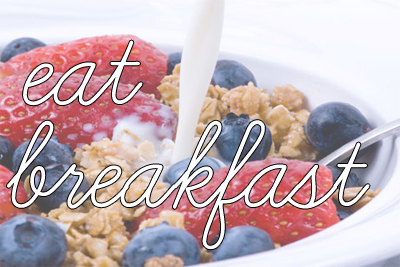
9. EAT SLOW
Put the brakes on fast eating. This isn’t a pie eating contest. This is time for you to enjoy every morsel of your meal. Use all of your senses while eating. It takes approximately 20 minutes for the stomach to send signals to the brain that it’s full. Take smaller bites, put the utensil down, chew slowly, and you won’t feel that uncomfortable I’M-GOING-TO-BURST feeling ever again.

9 reasons to eat breakfast
date: 2012-09-10  time: 21:09:00
time: 21:09:00
 time: 21:09:00
time: 21:09:00 HEALTHY EATING HABITS
It is well established that people who eat breakfast consume less fat and cholesterol and more vitamins, minerals, and fiber than people who skip breakfast.
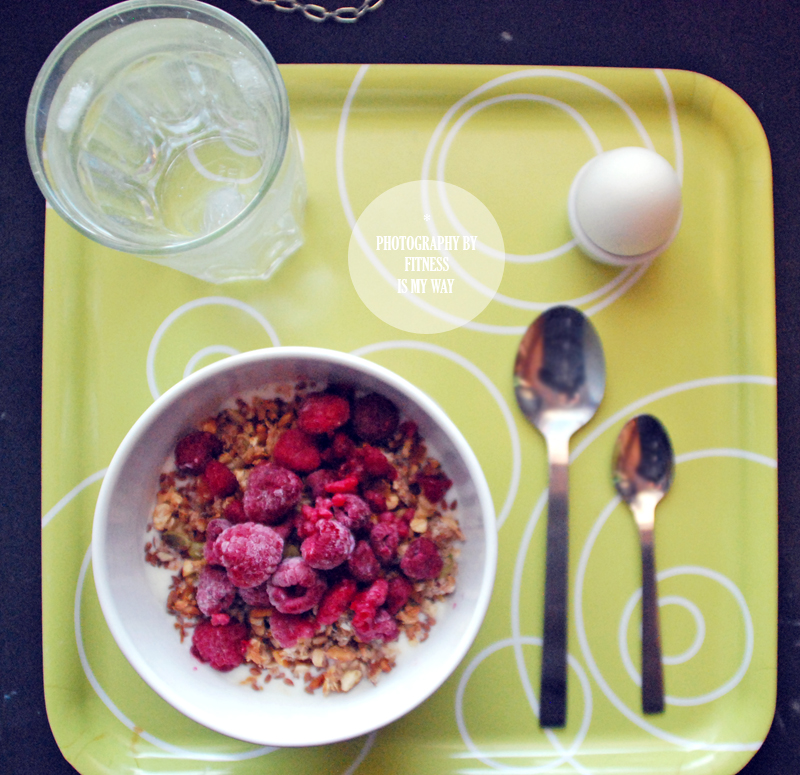
WEIGHT MANAGEMENT
The National Weight Control Registry reported that people who eat breakfast have an easier time managing their weight than people who skip breakfast.

PORTION CONTROL
In general, people who eat breakfast have an easier time controlling their caloric intake throughout the day than those who don’t.

REDUCED RISK OF DIABETES
A report by the American Heart Association showed that people who eat breakfast are significantly less likely to develop diabetes than people who skip breakfast.

MORE ENERGY
A healthy breakfast can provide your body with the nutrients that you need to stay energized for several hours.

FITNESS
It is believed that people who eat breakfast have more energy and therefore may participate in more physical activity than people who skip breakfast.

FOCUS
According to the American Dietetic Association, people who eat breakfast have an easier time focusing and are more productive throughout the morning than people who skip breakfast.

MEMORY
Eating breakfast improves memory and learning.

BETTER MOOD
Skipping breakfast can make you feel grumpy and fatigued throughout the day. Taking just 10 minutes to eat something in the morning can really improve your mood.
DON'T FORGET YOUR BREAKFAST PEOPLE!
DON'T FORGET YOUR BREAKFAST PEOPLE!

